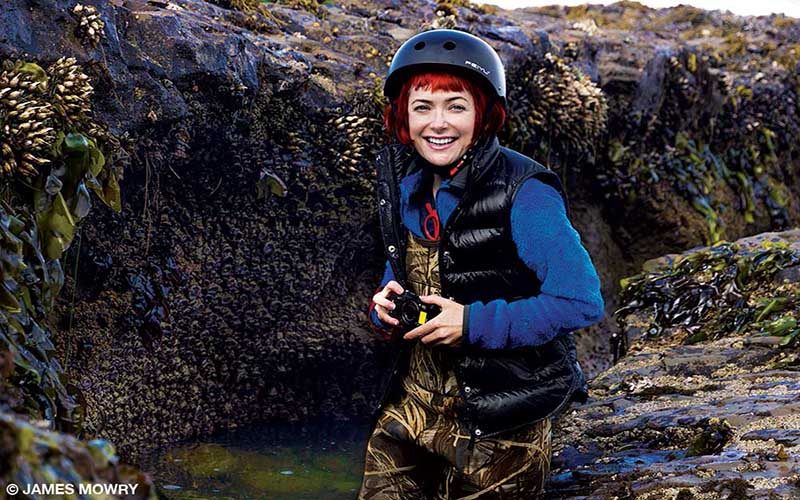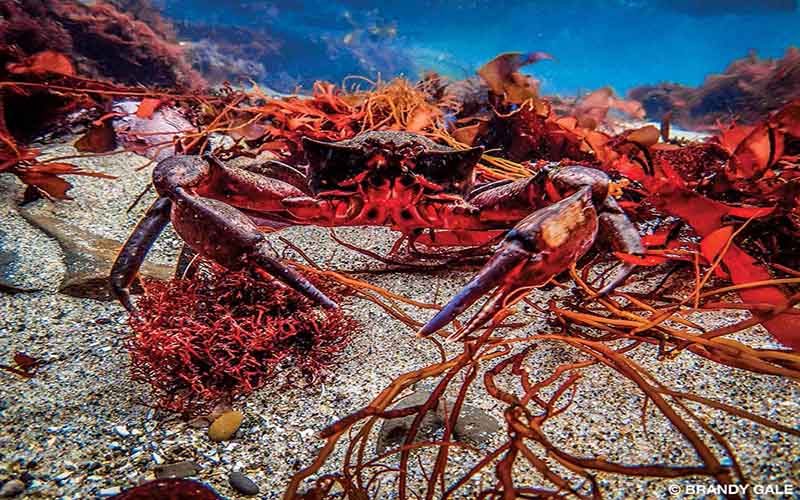With their colorful grandeur, fantastical inhabitants, gleaming iridescence and extraordinary diversity, tide pools are endlessly enchanting. Tide pools provide intimate glimpses of the life beneath the often-turbulent surfaces of coastal waters.
I have been avidly exploring these pools at low tide since moving to Santa Cruz, California, from inland Canada a few years ago. Frequently accompanying scientists in the field, I assist with counts and take photos for them to use in their research of the intertidal zones. Tide pools have become a major theme of my own artwork and subjects for recent exhibits of my paintings and photography. By going to tide pools, I can explore and create images of these surprising oceanic microcosms for hours; unfortunately, the creative time at the shoreline is limited to when the tide is out, so I shoot quickly and always keep an eye on the ocean.

The Intertidal World
Intertidal zones are layered strata of discovery. Marine biologists divide the intertidal area into three specific sectors (low, medium and high) based on the overall average exposure of the zone to air. Closest to shore, the high zone is submerged only during the highest of tides. The primarily marine low zone is exposed only during the most extreme low tides. Strikingly different ecosystems can exist between zones that are not far apart. All these factors play a major role in what you will find in any given tide pool.
The spectacular scenes found in tide pools are typically impossible to observe while scuba diving. In rocky areas close to the shore at low tide, gorgeously lit limpets, gangly gooseneck barnacles, ultramarine mussels, speckled sea stars and shieldlike chitons anchored to the rocks form beautifully mottled scenes. Diminutive snails find shelter among the small plants growing within pools carved in the rocks by waves over time. Clusters of turban snails and hermit crabs scuttling to and fro enliven the scene. Trapped in these rock pools among the colorful anemone, glittering urchins, sponges, tube worms, whelks, vibrant seaweeds and corals are various small fish, crabs and shrimp. Giant green sea anemones as large as dinner plates reveal themselves along with sea stars in orange, cream, blue, red and violet hues.
Further out, nudibranchs surfing on eel grass catch the eye. An especially low tide (relative to mean sea level) reveals ever more exotic sea anemone species, sea hares, abalone and even octopuses among the bull kelp and sea palms. While octopuses can become trapped in a tide pool for the duration of the low tide period, they usually do not stay there for long. Watching the uncannily intelligent cephalopods crawl overland to get to deeper water is a rare and fascinating sight.
Gather the Appropriate Gear
Acquiring the appropriate camera equipment and protective gear has helped to make these worlds more accessible. Donning chest or hip waders (or knee pads and rubber boots with a lug sole), a helmet and warm, layered clothing will keep you dry, safe and comfortable. A small, floating dry box case containing extra batteries, car keys and identification, first aid kit, whistle and beacon is always with me. A tide-monitoring device (such as tide tables or a tide watch) is essential. Smartphone apps that provide tide data are useful additions.
Macro photography is the best way to tell the stories of these locales. I make my best images by employing various submersible cameras and available light rather than strobes. Artificial lighting disturbs and stresses the animals and makes them hide; gloriously open sea anemones close tightly at such provocation. The living creatures found in tide pools are best enjoyed in their natural state, and available light will give you photos that appear true to the environment rather than looking as if you shot them in a tank. When photographing in such shallow water, artificially lighting the scene is unnecessary to capture the reds, oranges and yellows that cannot be seen at lower depths when diving. If shooting during a low tide as the sun is setting, end-of-day light can help produce the most dreamy natural images; the long, angled light rays make for interesting shadows and textures along with vibrant colors.

Leave the big dive rig at home. My Canon EOS Mark III in its underwater housing with lights is never going to fit inside a tide pool and is too cumbersome to wield on the craggy rocks between the waves. Carrying a huge, expensive camera while trying to negotiate rugged escarpments, razor-sharp mussels and slippery seaweeds is frustrating, unsafe and possibly costly.
Smaller cameras in underwater housings work fine in larger pools. One of my favorite setups is an Olympus OM-D E-M5 housed with a 60mm macro lens. Small waterproof sport cameras that do not require a housing above 30 feet are terrific tools to use between the tides; Canon, Olympus, Panasonic and other brands offer good options. While cameras with larger sensors will provide better overall image quality, I made some of my most artful images using children’s toy cameras in plastic bags or a smartphone in a waterproof case.
Macro photography has its challenges, particularly when using only available light. The result is often a very narrow depth of field. A digital image-processing technique called focus stacking — wherein multiple images taken at varying focal distances are combined to give a final image with a greater depth of field — can be useful if your subject is relatively still. For sharper shots and better depth of field, use a flexible mini tripod (secured with a dive weight) when shooting slower than 1/125 sec. to eliminate blur from camera movement.
Plan Your Trip
Consult local weather conditions and tide tables to plan your trip. The National Oceanic and Atmospheric Administration (NOAA) offers excellent tide predictions online. Minus tides are rare during daylight; you may have to wait several weeks for one to be available. Water clarity and visibility are additional considerations. Water gets murkier as the tide comes back in, so the best viewing usually occurs while the tide is going out.
The time of year will affect what sea life you will be able to observe. The most interesting time to visit tide pools in California is usually December through March.
Reduce Your Impact
Intertidal areas are protected, and some marine sanctuary conservation areas do not allow tide pooling. Determine in advance if your location requires permission.

Be careful to not harm the delicate environment of this precious ecosystem. Tide pool organisms are extremely sensitive to human activity. Just as you would not stand on a coral reef during a dive, don’t step on critters in a tide pool. Stay on rocks and sand, and take only photos.
Stay away from marine mammals resting on the rocks. Laws protect them, and they can be aggressive if threatened.
The intertidal realm can be very slippery, and a rogue wave could easily carry away you or your camera. Rescues in these areas can be fraught with challenge and expense. Always keep an eye on the sea, and bring a buddy with you.
Set Your Goals
Identifying animals and plants can be an enjoyable task. Many books can provide information on intertidal creatures, and some online clubs focus on identification of the vegetation and wildlife that encompass the vast biodiversity found in coastal areas. I recommend Ed Ricketts’ superb tome Between Pacific Tides.
Unless I am working with a research team that is seeking images of specific flora or fauna, I try to look for the artistic shot rather than cataloging or taking a photo of every nudibranch species, for example. My desire is to capture the critter’s-eye view of its world and collect macro imagery that can often be quite abstract.

I have synesthesia, a neurological condition in which my senses are all crossed. For example, I can hear colors, shapes have a flavor, tastes have a sound, and so on. This condition informs my creative work. My best photos result when I have my camera settings perfect for collecting the most intense color; when submerging the camera, I let all my senses guide the shot. Photographers’ images will vary according to their muse, settings and vision.
Tide pooling is a wonderful way to gently acquaint others with the ocean and perhaps to get them interested in becoming divers. While I am now a certified diver, I was afraid of the water for most of my life. By summoning the courage to overcome the inner obstacles that prevented me from enjoying the ocean, I am now rewarded with the images I create there and am able to travel and experience the ocean with others. The wonder and beauty of tide pooling got me started on this journey. On days that I am unable to go diving, the tide pools are there for me to savor.
There are certain sea anemones that I often return to visit. Two strawberry anemones at Carmel, California, are like old friends when I see them now. It must be a super low tide for me to safely get to them and to photograph the pair in their intertidal burrow. It’s a very sweet, connected feeling for me to observe these two organisms thriving in an area usually covered by pounding surf.
Introducing others to tide pools is a source of great joy for me. Capturing my mind and heart, these magical aquariums offer abundant subject matter for my artistic pursuits. I thrive as an artist and as a person where the waves meet the shore.
| © Alert Diver — Q4 2018 |